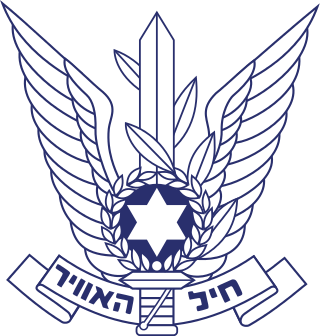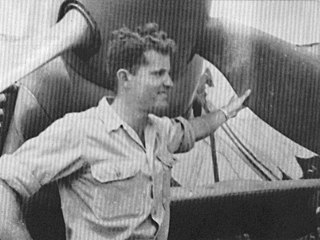
The Israeli Air Force operates as the aerial warfare branch of the Israel Defense Forces. It was founded on May 28, 1948, shortly after the Israeli Declaration of Independence. As of April 2022, Aluf Tomer Bar has been serving as the Air Force commander.

Operation Focus was the opening airstrike by Israel at the start of the Six-Day War in 1967. It is sometimes referred to as the "Sinai Air Strike". At 07:45 on 5 June 1967, the Israeli Air Force (IAF) under Maj. Gen. Mordechai Hod launched a massive airstrike that destroyed the majority of the Egyptian Air Force on the ground. Following Syrian and Jordanian attacks in retaliation, the Israeli Air Force proceeded to bomb air bases in those countries. By noon, the Egyptian, Jordanian and Syrian Air Forces, with about 450 aircraft, were destroyed. It was also very successful in disabling 18 airfields in Egypt, hindering Egyptian air operations for the duration of the war, and remains one of the most successful air attack campaigns in military history.

The 69 "Hammers" Squadron is an Israeli Air Force squadron operating the F-15I Thunder out of Hatzerim. It was formed in July 1948 to operate three B-17 Flying Fortresses which the fledgling Israeli Air Force had acquired in the United States. The squadron flew the Flying Fortress, a type credited with propelling the IAF into the realm of modern aerial warfare, during both the 1948 Arab–Israeli War and 1956 Suez Crisis. Disbanded in early 1957, 69 Squadron reformed in 1969 to fly the F-4 Phantom II. 69 Squadron operated the Kurnass (Sledgehammer), as the Phantom was known in Israel, for 25 years and its Phantoms saw extensive action during the War of Attrition, Yom Kippur War, First Lebanon War and numerous engagements in between. The squadron often played a central role in IAF suppression of enemy air defences (SEAD) efforts and took part in repeated battles against Egyptian and Syrian air defence arrays.

The Fouga CM.170 Magister is a 1950s French two-seat jet trainer aircraft that was developed and manufactured by French aircraft manufacturer Établissements Fouga & Cie. Easily recognizable by its V-tail, almost 1,000 have been built in France and under licence in West Germany, Israel, and Finland.

The Dassault MD.454 Mystère IV is a 1950s French fighter-bomber aircraft, the first transonic aircraft to enter service with the French Air Force. It was used in large-scale combat in the Israeli Air Force during the 1967 Six Day War.
Operation Boxer was an aerial offensive undertaken by the Israeli Air Force along the Suez Canal in July 1969. The first major IAF operation since the 1967 Six-Day War, the operation signaled a new phase in the War of Attrition.
Bir Gifgafa is an airfield in the Sinai, 90 km east of the Suez Canal. During the 1960s and 1970s it played a significant role in Arab–Israeli wars, at different times serving both Egypt and Israel.

The IAF Aerobatic Team is the aerobatic display team of the Israeli Air Force. Until summer 2010 the team flew the IAI Tzukit, a variant of the French Fouga Magister manufactured under license by Israel Aerospace Industries. Since then the team operates four Beechcraft T-6 Texan II aircraft.
Rimon 20 was the code name of an aerial battle in 1970 which pitted the Israeli Air Force directly against Soviet fighter pilots stationed in Egypt during the War of Attrition. Israel planned the dogfight in order to send a message that it would no longer tolerate direct Soviet military involvement in its conflict with Egypt.

115 Squadron, also known as the Flying Dragon or Red Squadron, is the Israeli Air Force's aggressor squadron. Based at Ovda, it is the sole IAF squadron to operate fixed-wing aircraft, helicopters and also ground-based assets.

Giora Romm is a former deputy commander of the Israeli Air Force (IAF), Israel's former military attaché in the United States and the current director of the Civil Aviation Authority of Israel. Romm was the Israeli Air Force's first jet ace, scoring five kills during the 1967 Six-Day War. In 1969, during the War of Attrition, Romm was shot down and spent several months in Egyptian captivity. He commanded the IAF's 115 Squadron through the intensive fighting of the 1973 Yom Kippur War and participated in Operation Wooden Leg, the 1985 raid against PLO headquarters in Tunisia.

Amir Nachumi is a retired Israeli Air Force Brigadier General who, in the course of his career, shot down 14 enemy aircraft, making him one of Israel's top flying aces. He scored 7 aerial kills in the F-4 Phantom II during the Yom Kippur War, 7 in the F-16 Fighting Falcon in fighting over Lebanon, and participated in Operation Opera, the 1981 raid that destroyed an Iraqi nuclear reactor.

The 1973 Syrian General Staff Headquarters Raid was an aerial strike carried out by the Israeli Air Force on October 9, 1973, the fourth day of the Yom Kippur War. Following a strike by Syrian surface-to-surface missiles against settlements and installations in northern Israel, seven F-4 Phantom IIs from 119 Squadron attacked the Syrian General Staff Headquarters (GHQ) and adjacent buildings in downtown Damascus.

Mordechai "Modi" Alon was an Israeli fighter pilot who with the formation of the Israeli Air Force in May 1948, assumed command of its first fighter squadron. Flying the Avia S-199, Alon participated in the IAF's first combat sortie on 29 May 1948, and on 3 June scored the IAF's very first aerial victories, downing a pair of Royal Egyptian Air Force C-47s over Tel Aviv.

The Galilee Squadron was an aerial unit established by the Yeshuv during the 1948 Arab-Israeli War to assist the Jewish war effort in northern Palestine. Initially a part of the Sherut Avir, the aerial arm of the Haganah, it was absorbed into the fledgling Israeli Air Force (IAF) upon the latter's formation on 28 May 1948. The unit served throughout the war, following which it was amalgamated with several other units to form the IAF's 100 Squadron.
149 Squadron, often referred to as the Smashing or Shattering Parrot squadron is a former unit of the Israeli Air Force. Active from 1976 to 1991, the squadron flew the A-4 Skyhawk and IAI Kfir.

Ran Goren is a retired fighter pilot and Major General of the IDF, former Deputy Commander of the Air Force and Head of the Manpower Directorate.

Ran Ronen was an Israeli Air Force (IAF) brigadier general and fighter ace credited with seven kills. He commanded various fighter squadrons, the IAF flight academy, and Tel Nof Airbase, retiring from the IAF with the rank of brigadier general. One of his pilots later described him as "the greatest squadron commander ever".

Rami Harpaz was a Colonel in the Israel Defence Forces and an IDF prisoner of war during the War of Attrition. Harpaz served as a fighter pilot in the Israeli Air Force and spent three and a half years in an Egyptian prison. Following his release, he returned to the air force, and came to command the IAF base at Ramat David.

Rina Levinson-Adler was one of the first three female pilots admitted to the Israeli Air Force (IAF) pilot training course.



















